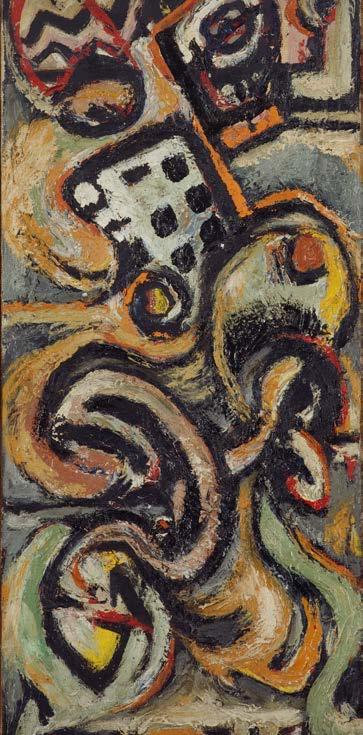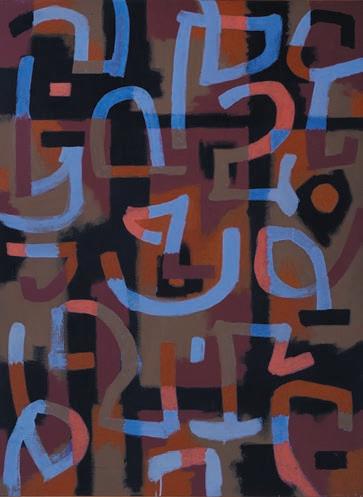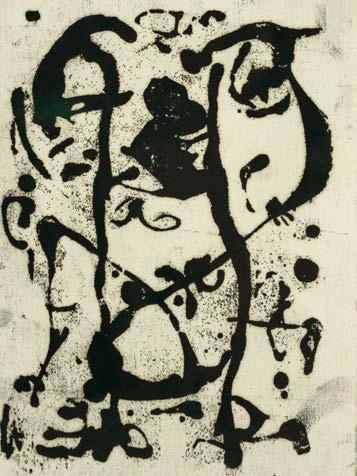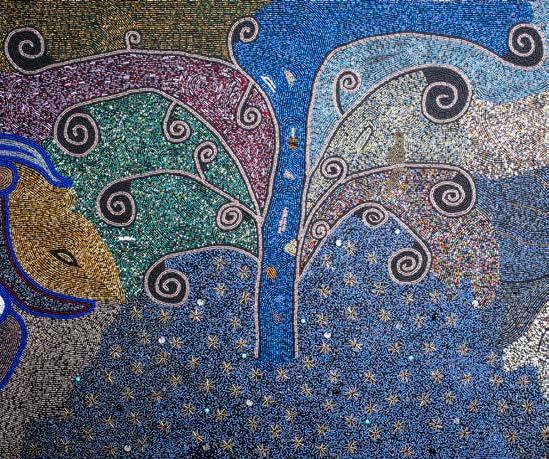
6 minute read
Art Exhibitions
Tickets are $10 for admission to all galleries • No charge for Four Arts members The Four Arts app ■ www.fourarts.org ■ boxofficestaff@fourarts.org ■ (561) 655-7226
-Charles and Jackson Pollock, continued from Page 1
surviving sculpture, and a wide selection of prints.
“The prints, drawings, and pages from a sketch notebook reveal more of his inner workings,” said Rebecca A. Dunham, The Four Arts’ head of fine arts and curator. “You can see him working out ideas before implementing them in a finished artwork. Most people know of Jackson Pollock from his drip paintings, but this exhibition touches upon other aspects of his life and his creative family.”
Charles took up painting and drawing at the age of 15, fascinating his four younger brothers, and encouraged Jackson to pursue art. It was Charles who brought Jackson to New York City to study at the Art Students League under Thomas Hart Benton, and both were indoctrinated with Benton’s Regionalism. While Jackson stayed on in New York City, eventually turning to abstraction, and becoming a central figure in the nascent avantgarde, Charles moved to Michigan, first working for the WPA before accepting
Charles Pollock, Rome 7, 1963, oil on canvas, 170 by 140 cm. Courtesy of American Contemporary Art Gallery, Munich. © Charles Pollock Archives, Paris.
Related presentations
David Anfam, Ph.D.
Jackson Pollock: What is a Classic?
VIRTUAL LECTURE: January 27, 2021 at 2:30 p.m.
David Anfam is a leading authority on modern American art. In 2016-17 he curated the exhibition Abstract Expressionism at the Royal Academy of Arts, London, the largest survey of its kind held in Europe.
Philip Rylands, Ph.D.
Origins of Modernism in Art: Abstraction
IN-PERSON LECTURE: March 1, 2021 at 11:30 a.m.
This Campus master class concludes with a talk on Jackson Pollock, whose “Abstract Expressionism” signaled the end of the abstract tradition begun with the pre-World War I avant-garde.
a professorship at Michigan State University. He too, in the mid1940s, turned to abstraction.
The exhibition displays about 70 of Charles Pollock’s works, including a wide variety of drawings, prints, and paintings organized chronologically into thematic groupings. Visitors can trace Charles’ development from his Chapala series in the 1950s to his “Post-Rome” works in the 1960s to his Arches series in the 1980s.

Jackson Pollock, Composition with Motif of Small Squares, 1938-41, oil on canvas, 59.5 by 26 cm. Private collection. “Charles’ work is more structured and resembles ‘color field’ painting,” Dunham said. “It’s more contemplated, where Jackson’s work is more about whatever was flowing creatively out of him at that moment. Charles has a different mode of operation, a different way of creating an abstract work.”
Hübner, the director of the American Contemporary Art Gallery in Munich, Germany, which represents Charles Pollock’s estate, helped The Four Arts organize the exhibition.
“This is not a pre-packaged, traveling show,” Dunham said. “This has been specifically designed in-house by Dr. Rylands, and all the artworks are borrowed from various private collectors or institutions. It’s a unique audience experience, the first-ever exhibition pairing of these brothers.”

Charles Pollock, Chapala, 1956, oil and tempera on canvas, 122 by 92.5 cm. Courtesy of American Contemporary Art Gallery, Munich. © Charles Pollock Archives, Paris. The exhibition also features two four-legged stools used by Jackson Pollock as he produced his works, along with two photos of Jackson at work by famed art photographer Hans Namuth.
“These photographs show Jackson Pollock as most people think of
Charles and Jackson Pollock is curated by Philip Rylands, President of The Society of the Four Arts, and Otto Hübner, and is organized by The Four Arts.
Jackson Pollock, Untitled M24, 1946, monotype, 21.6 by 14 cm. Courtesy of American Contemporary Art Gallery, Munich. © The Pollock-Krasner Foundation, New York.

him, working on his action drip paintings,” Dunham said. “You can see how all the various drips and splashes of paint refer back to how he was moving his hands and moving the paint stick. You can see the gestures and you understand that the artist was making art that was the outcome of the movements of the body.”
A self-guided tour is available for smartphones by clicking on fourarts.oncell.com. Please bring your headphones to enjoy the tour.
The Four Arts hopes that visitors to this exhibition gain a deeper understanding of Jackson Pollock and a welcome introduction to Charles Pollock.
“While Jackson Pollock was the more important painter during his lifetime,” Dunham said, “this show sheds light on the fact that Jackson had an older brother Charles who was also an extremely gifted and talented painter.”

Last chance to see Ubuhle Women and In God We Trust
There is still time to take in the Four Arts’ first two art exhibitions of the season. Ubuhle Women: Beadwork and the Art of Independence, runs through January 17. This exhibition showcases a new form a bead art, the ndwango, developed by a community of women living and working in rural South Africa.
The artists featured in the exhibition call their paintings in beads ndwangos, which translates as “cloth” or “rag.” The black fabric on which the Ubuhle women work is reminiscent of the Xhosa headscarves and skirts which many of them grew up wearing. By stretching this textile like a canvas, the artists transform the flat cloth into a contemporary art form colored with Czech glass beads.
The exhibition includes a free 32-page gallery guide and a 15-minute video, both created by the Smithsonian, and black-and-white photographic portraits of the Ubuhle artists taken by worldrenowned South African photographer Zanele Muholi.
Rare book and history aficionados will enjoy In God We Trust: Early Bible Printings and Founding Documents from the David M. Rubenstein Americana Collection, an extraordinary exhibition of historic American Bibles, religious texts, and historic documents.
Carey, Stewart, and This exhibition, which also runs Co., printers, The Holy Bible, Translated from the Latin Vulgate, through January 17 and then returns January 30 though Philadelphia, 1790, February 28, features 18 books David M. Rubenstein Americana Collection. and five founding documents from the Americana Collection of Mr. Rubenstein, a prominent American businessman and philanthropist. Organized by the New-York Historical Society in collaboration with Mr. Rubenstein, In God We Trust presents the stories of these artifacts and the ingenuity and diversity of the early Americans who made them.
Ntombephi Ntobel, Tree of Life, 2006, glass beads sewn onto fabric

Ubuhle Women Beadwork and the Art of Independence In God We Trust Early Bible Printings and Founding Documents from the David M. Rubenstein Collection
ON DISPLAY
Through Sunday, January 17 (In God We Trust also runs January 30-February 28) Esther B. O’Keeffe Building, 102 Four Arts Plaza
DAYS AND TIMES
Monday: 10 a.m. to 5 p.m. Tuesday - Four Arts members only: 1 to 5 p.m. Wednesday through Saturday: 10 a.m. to 5 p.m. Sunday: 1 to 5 p.m.
TICKETS
$10; no charge for Four Arts members Reserve tickets through The Four Arts app, by clicking on www.fourarts.org, calling (561) 6557226, or visiting the Four Arts Box Office
Ubuhle Women was developed by the Smithsonian Anacostia Community Museum, Washington, DC in cooperation with Curators Bev Gibson, Ubuhle Beads, and James Green, and is organized for tour by International Arts & Artists, Washington, DC.

In God We Trust has been organized by the New-York Historical Society in collaboration with the David M. Rubenstein Americana Collection.









